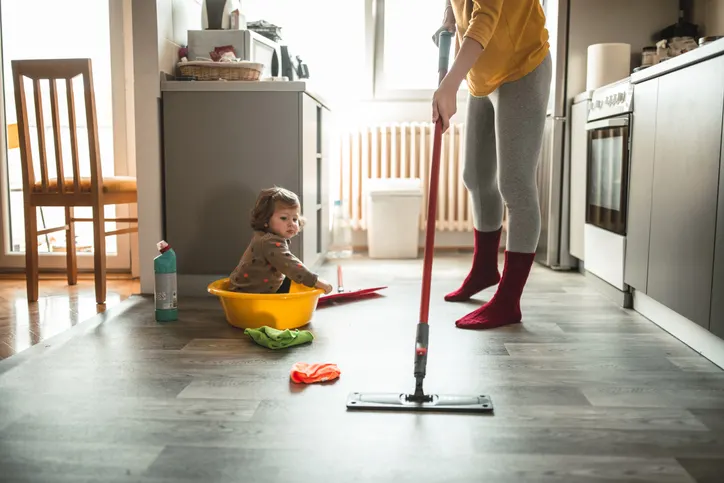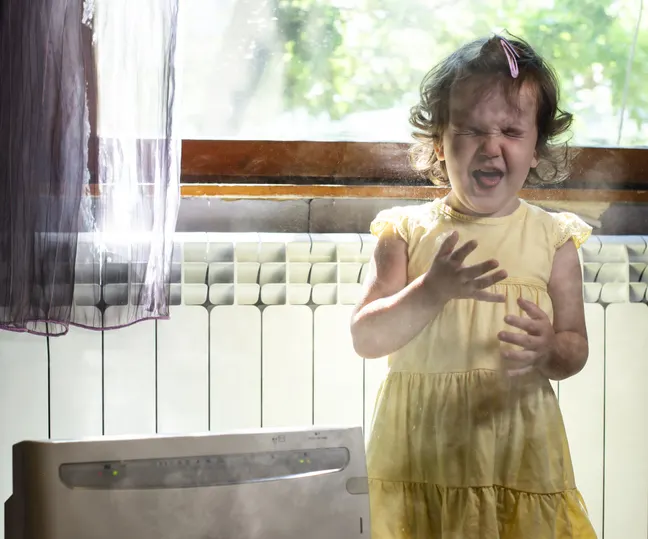Your home might look neat and tidy on the surface, but the human eye only evolved to see macroscopic objects, like tables, people, and food. It didn’t develop an ability to see microscopic particles in your environment. And that’s a problem.
You can understand why biology didn’t give us a perfect vision. Our eyes would need to be massive, and our brains even larger to process all the incoming information. Thus, evolution made a compromise. We got eyes that were good enough to allow us to navigate the world at the level most of us operate daily, at the cost of being unable to see things smaller than about half a millimeter in diameter. It was a trade-off.
But today, the biggest threats we face in our homes aren’t just from large objects. They also come from very small particles as well. We don’t think about them a lot because we can’t see them. But science tells us that they are there, and some of them could be wreaking havoc with your family’s health.

All The Weird Particles Lurking In Your Home
In this post, we take a look at some of the weird and wacky particles lurking in your home and what, if anything, you can do about it.
Dust Mites
Dust mites are tiny creatures that feed off dead human skin. You can’t see them without a microscope because they are so small. But when you do, you can’t help but feel a little creeped out. Unfortunately, these things are everywhere, including on the surface of your body right now.
The good news is that dust mites are generally harmless. They don’t carry disease or irritate the skin. But even the idea that they are there is a little unpleasant.

Phthalates
Phthalates are a common household chemical, found in everything from shampoo to cleaning products. For years, manufacturers added this collection of chemicals to their products to increase shelf life and improve the tactile qualities of their formulations.
Unfortunately, researchers are increasingly coming to the conclusion that this substance is harmful to our bodies. They now believe that it might be an endocrine disruptor, which means that it changes hormonal balances. What’s more, because it is a synthetic chemical, it tends to linger for many years, accumulating over time.
To avoid this chemical getting into your environment, look for products labeled “phthalate-free.”
Skin Cells
The skin cells in your body turn over completely once every three to six months. You don’t notice it happening because it occurs so slowly. But over time, you can see the effects of it in your home. Dust builds up on your banisters and railings, and you wonder where it comes from.
While some dust particles float in through the windows, the vast majority of it comes from the bodies of people living in your home. Again, just like dust mites, it is a completely natural process, but it is also a little gross. As you walk around your home, you’re breathing in your own dead skin cells and those of your family.
It won’t surprise you to discover that vacuuming is the most effective way to scoop up and eliminate dust. Dust is mostly desiccated, which means that it lifts off carpets, floors, and upholstery easily.

Clothing Fibres
Most clothes are made from natural fibers that break down in the environment, such as cotton and wool. Thus, over time, as you walk around your home, tiny bits of your clothing slough off and fall towards the floor. These then collect alongside all of the other sources of dust to create an unwanted crust on your furniture and floors.
Soil Particles
Soil is interesting. Essentially, it’s what biological matter looks like, once worms, bacteria, and insects have extracted all the energy they can from it. For that reason, it is usually harmless, even if you eat it (although you should not do this in practice).
Soil, though, is what completes the cycle of life. Once old vegetation and animal matter rot down and return to the Earth, it provides the ideal substrate for new growth. And that’s a problem. If enough soil gets into your home, it can lead to the development of plants and mold in places you don’t want it.
Fortunately, reducing the number of soil particles entering your home is simple. Just make sure that you keep all outside footwear on your porch.
 Pollen
Pollen
Pollen looks like dust to the naked eye, but it is fundamentally different. Unlike the other components of dust we’ve discussed so far, it has the capacity to produce a new living organism – something that skin cells can’t do.
Pollen is problematic if people in your home have asthma or other allergies. Certain receptors on the surface of the material trick the body into thinking it is being attacked by a dangerous agent, leading to severe allergic reactions, like hayfever.
Keeping pollen out of your home requires doing three things:
- Closing all windows during pollen season and relying instead on your HVAC to regulate the temperature in your home.
- Leaving shoes on the porch to avoid dragging pollen particles into the house where they can become lodged in the carpet.
- Regularly vacuuming and deep cleaning carpets and upholstery to prevent pollen buildup.
- Make sure there aren’t any other entry points for pollen in your home. If you have a hole in your roof, pollen could be entering through here. Contact local roofers to resolve this.
Some pollen will inevitably get into your home no matter what you do. But the lower the levels, the less severe the reaction of the allergic person.
 Viruses
Viruses
Most scientists view viruses through scientific research as particles that display “life-like” features. Whether these critters are actually alive or not is a matter for philosophical and scientific debate, but there are currently billions (if not trillions) of them in your home.
Even before COVID-19, many homeowners were worried about virus levels in their properties. They knew from the germ theory of disease that viruses cause infection and could potentially put their families at risk.
In the old days, people would use air filters to strain out virus particles from the air. But unfortunately, virus particles are incredibly small, and the technology simply wasn’t effective enough.
Today, we have new and better technologies. Molekule is a pioneer in this area. The company creates PECO filters that work differently from the run-of-the-mill variety. Instead of capturing viruses, these new systems subject them to a chemical reaction that breaks them down into their constituent parts, fundamentally changing their nature.
When you learn more about the history of the Molekule, you discover that the idea came from a recognition of the inadequacy of existing systems. People wanted air purifiers and filters that actually solve indoor air quality issues and didn’t just paper over them.
The technology captures viruses and deactivates them, which is a relief during this era of pandemics.
Specks Of Plastic
Nothing that people make lasts forever, except for plastic maybe.
Unfortunately, though, plastic doesn’t just remain in its whole form as it comes out of the factory. Instead, it breaks into smaller and smaller pieces over time, eventually to the point where you can’t even see the individual particles.
The small particle size of plastics is one of the reasons why the oceans are currently under such threat from plastic pollution. Plastic waste is breaking down into tiny pieces that are then finding their way into the marine ecosystem where they are affecting fish fertility and ecosystems.
Specks of plastic in your home are also a potential source of danger. Most researchers advise against consuming plastic because of how it might disrupt hormonal signaling in your body.
 Volcanic Particles
Volcanic Particles
A lot of the dust in your home also comes from volcanic eruptions.
Volcanism is the primary source of dust in the atmosphere and one of the reasons the sky goes dark after a major eruption. High heat and rock combine to spew trillions of tiny particles into the air that act as a giant cloud. Eventually, gravity does its work and they return to Earth, covering the landscape.
If you’ve ever been to a site of a recent volcanic eruption, you’ll notice that the soil is incredibly rich and thick. Fresh eruptions usually have a layer of dust all around them where particles settle.
This ash can eventually find its way into your home, even if you live on the other side of the world. Again, it won’t hurt you, but it could make your rooms look dustier if you don’t clear it up quickly.
Sand
The sand in your home probably doesn’t come from the beach. As far as the world’s sand reserves go, beaches are a minor supplier. The main exporter of sand is the world’s deserts, particularly the Sahara.
High winds whip up small sand particles (which are just tiny pieces of rock) and throw them into the atmosphere which carries them to your home before finally depositing them. In the days after a sandstorm, you can often notice vehicles covered in a thin layer of material which can be a hassle to wipe off.

Thus, there are numerous weird particles floating around your home. Your job is to identify and control them before they cause any damage or harm.

Jessi is the creative mind behind The Coffee Mom, a popular blog that combines parenting advice, travel tips, and a love for all things Disney. As a trusted Disney influencer and passionate storyteller, Jessi’s authentic insights and relatable content resonate with readers worldwide.

Hand Washing Dishes and Unexpected Consequences — The Coffee Mom
Thursday 28th of December 2023
[…] I am washing the dishes right away, the sink is usually rather clean and empty […]
7 Simple Suggestions For A Strong Relationship — The Coffee Mom
Wednesday 6th of January 2021
[…] of relationship that you’re looking for. Because when it comes to being happy, creating a secure home and family life, it’s important to make sure that you have a strong relationship in place. After […]